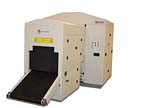News & Notes

Curtainwall on Federal Building Combines Security, Aesthetics
Tenants of the Des Moines [Iowa] Federal Building will soon be enjoying a structurally sound and energy-efficient façade, thanks in part to the customized, protective curtainwall by Wausau Window and Wall Systems. Currently being installed in the fully occupied building, the system adheres to heightened security measures mandated by the federal government, while maintaining the aesthetic integrity of the architect’s design.In the spring of 2001, the government appropriated funds to provide significant upgrades to the building’s interior and exterior, including installation of a blast hazard mitigating façade. Detroit-based design firm SmithGroup won approval for its concept. Working from SmithGroup’s schematics, Des Moines-based general contractors Neumann Bros. enlisted the help of Wausau Window and Wall Systems, and Northwest Steel Erectors to design a curtainwall system that would turn the architectural vision into reality.
The building’s east and west sides feature a modified RX Series window wall, while the south elevation displays an eight-inch deep, unitized system with three-inch covers and factory-glazed Alpolic panels manufactured to match the field-installed panels of the other elevations. The building’s north elevation is undergoing the most dramatic change in appearance using a custom, stacking, vertically glazed curtainwall. To accentuate the floor lines, it showcases a 12-inch high by six-inch deep reveal. Additionally, the Bone White Duranar finish used on the north facade presents a striking change from the building’s original grey concrete exterior. Visit www.wausauwindow.com.
In another facility protection scheme and originally used by the U.S. Armed Forces for force and critical equipment protection in forward areas, Metalith has been modified by its maker CMI of Chicago to accommodate the increasing demand for the protection of government, military, industrial and commercial sites. The perimeter security system has received the U.S. State Department’s highest certification (K12).
The Metalith is a prefabricated steel wall structure that offers blast mitigation, blast containment, force protection, anti-ram vehicle protection, cost efficiency and ease of installation. Visit www.corrugated-metals.com.

L-3 Communications in Air Cargo Screening Pilot Program
L-3 Communications of New York City says that its subsidiary, L-3 Communications Security and Detection Systems, has been selected by the U.S. Transportation Security Administration to participate in a break-bulk air cargo screening pilot program using the company’s eXaminer 3DX 6000 certified Explosives Detection Systems. The TSA pilot program will be taking place in air carrier cargo facilities at Miami International Airport, Chicago O’Hare International Airport, Los Angeles International Airport and Ted Stevens International Airport, Anchorage.
Virtual Classroom Training
Compass Technologies, Exton, Pa, is now offering a novel interactive Web-based training program (IWBT) to its business partners. The instructor-led training program is conducted in a virtual classroom and stresses student retention and follow-up, including e-mail, recorded sessions, bulletin boards and chat rooms. Visit www.compasstec.com.Assa Abloy GTD HQ in Providence, R.I.
The Assa Abloy Global Technologies Division has established the company’s worldwide headquarters in Providence, Rhode Island, U.S.A. GTD personnel to be located in the new facility include Joe Grillo, Assa Abloy EVP and president and CEO of GTD; Karen Fournier, executive assistant to Grillo; Steve Finney, GTD controller; and Brent Archer, newly appointed GTD vice president of operations.Airports Unveil Explosive Detection Solutions
The Transportation Security Administration (TSA) announced that San Diego International Airport has become the third airport in the country to launch a live pilot of GE’s EntryScan walk-through explosives detector, the largest airport yet to do so.Some passengers at the airport will be asked to step into the trace portal and remain still for a few seconds while several quick puffs of air are released, prior to walking through the metal detector. The pilot program will last 45 days and is expected to yield important data on technology effectiveness, passenger wait times and impact on airport operations. Visit www.geinfrastructure.com.
Tampa International Airport recently implemented a new multi-user in-line baggage handling system. Fully integrated with its 21 explosive detection systems (EDS) machines, the system screens checked baggage for all airlines serving the airport. The Aviation Authority selected Skanska of Solna, Sweden to design and build an in-line baggage screening system that utilized TSA-certified explosive detection technology in order to meet a federal requirement for complete EDS screening of checked baggage.<
Looking for a reprint of this article?
From high-res PDFs to custom plaques, order your copy today!


